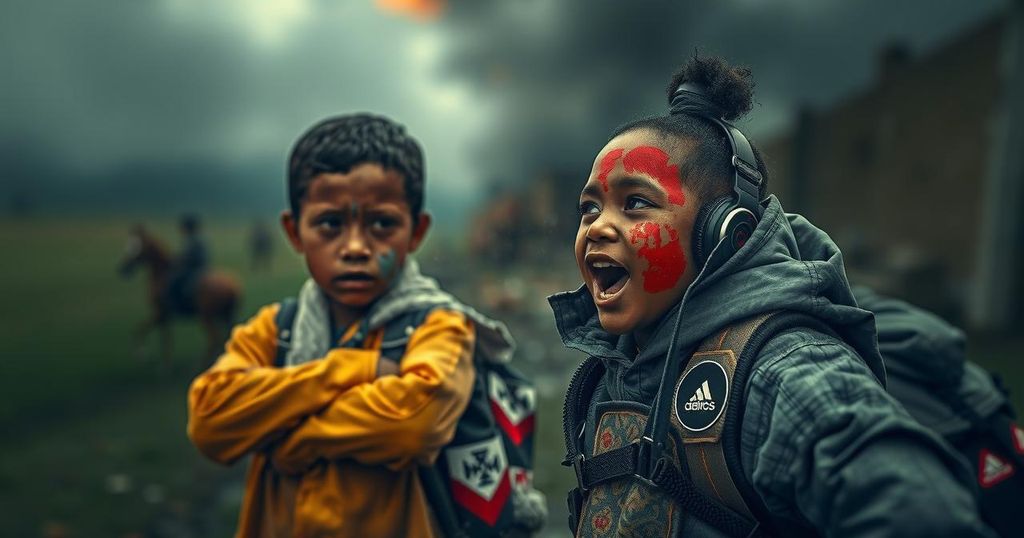The article discusses the critical needs of children impacted by armed conflict and climate change, emphasizing the necessity for a dual approach that integrates climate and child-focused perspectives in decision-making. A recent report noted the alarming link between climate insecurity and violations against children in conflict zones, highlighting that nearly 1 billion children live in high-risk countries. The calls for leaders to include these considerations in peace and security discussions, and ensure sustainable solutions backed by adequate funding, are pressing.
As the world continues to confront an array of armed conflicts, such as those in Ukraine and Gaza, there is an increasing call for a more attentive approach to addressing the needs of children impacted by both warfare and climate-related crises. A 2023 paper illustrated the concerning correlation between climate insecurity and severe violations against children in conflict zones, encompassing issues such as recruitment and humanitarian access. The UN Special Representative for Children and Armed Conflict (CAAC) underscored the critical need for decision-makers to adopt a combined perspective that integrates climate concerns with a focus on children’s needs. One year after the release of this report, the UN climate conference held in Baku, Azerbaijan, positioned this dual approach at the forefront of discussions. The Special Representative noted the necessity of addressing the intersection of climate change, peace, security, and the well-being of children affected by armed conflict. “Children have been the most impacted by both armed conflict and climate insecurity,” stated Gamba. She emphasized the pressing issue of the absence of children within climate, peace, and security dialogues, advocating for their inclusion in formulating sustainable solutions. The UNICEF Children’s Climate Security Risk Index has revealed that almost 1 billion children globally reside in countries classified as extremely high-risk due to climate change, which exacerbates conditions leading to conflict-induced displacement. The collaboration between the International Organization for Migration (IOM) and UNICEF has yielded guiding principles acknowledging the need for protection of children’s rights amidst climate change and conflict. Gamba urged leaders to integrate the plight of children affected by conflict in discussions surrounding climate, peace, and security, and called for financial commitments directed towards sustainable solutions that encompass both challenges. She remarked, “Supporting flexible funding for emergency response that considers both children affected by armed conflict and climate peace and security can have a multiplier effect.” The report from the IPS UN Bureau reinforces the need for urgent action amid these intertwined crises, stressing that a collective response involving all stakeholders is crucial for safeguarding the rights and futures of vulnerable children.
The ongoing armed conflicts around the world, particularly in regions like Ukraine and Gaza, have serious implications for children. These conflicts, combined with the effects of climate change, have heightened vulnerabilities, necessitating a comprehensive understanding of their challenges. Recent studies indicate a notable connection between climate-related issues and significant violations against children, including forced recruitment and lack of access to humanitarian aid. With nearly one billion children living in high-risk environments, the health and well-being of this demographic demand urgent attention from policymakers, humanitarian organizations, and global leaders. Effective strategies that incorporate child-focused perspectives with climate considerations are essential for addressing these multifaceted crises.
In summary, the urgent plight of children affected by armed conflict and climate change deserves immediate attention and action from global leaders. The intersectionality of these issues highlights the necessity for inclusive strategies that recognize the unique challenges faced by young people in crisis zones. By embracing a dual approach—simultaneously addressing climate change and safeguarding children’s rights—stakeholders can work towards sustainable, impactful solutions. Enhanced funding and commitment to these integrated strategies can ultimately lead to a better future for vulnerable children worldwide.
Original Source: www.ipsnews.net






